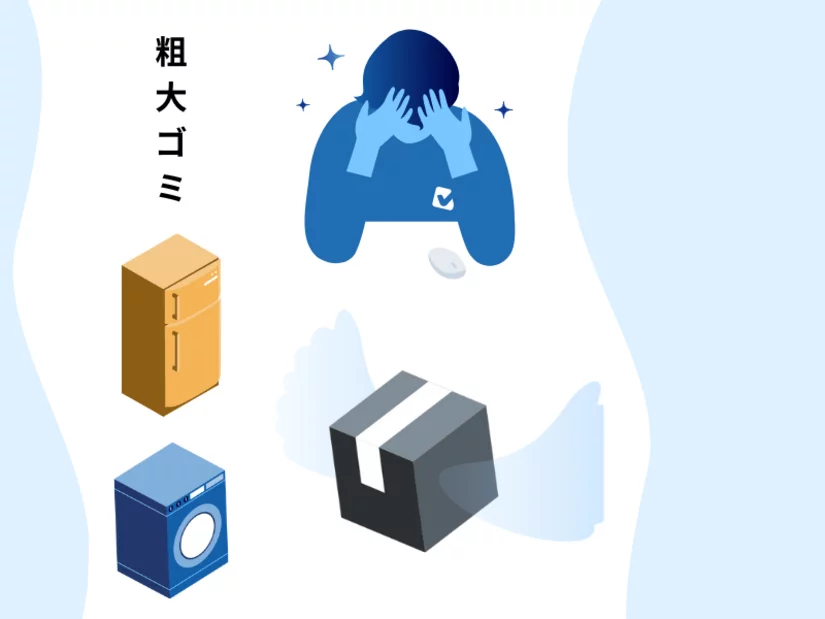Moving in Japan: How to Dispose of Unwanted Belongings

Moving in Japan: How to Dispose of Unwanted Belongings
When moving in Japan, disposing of unwanted belongings can be surprisingly complex, particularly for bulky items like furniture and appliances. Many residents are familiar with Japan’s strict garbage sorting rules, which vary by region, but large items such as sofas, beds, refrigerators, and washing machines require additional steps.
Handling these items efficiently is crucial to avoid last-minute hassles and potential fines. The disposal process can take several weeks, so planning ahead is essential. This guide explains how to manage bulky item disposal, including alternatives like selling, recycling, or donating.
1. Understanding Sodai Gomi: Large-Size Trash
In Japan, Sodai Gomi (粗大ごみ) refers to any item larger than 30 cm in height, width, or depth. This category includes most large household items, but certain electronic appliances are excluded due to Japan’s recycling laws.
Excluded Appliances
- TVs, air conditioners, refrigerators, washing machines, and personal computers
- These items fall under the Home Appliance Recycling Law (家電リサイクル法) and must be collected by a licensed recycling facility or store.
If you’re planning a move, ensure you understand the requirements for disposing of Sodai Gomi. Handling the process early helps you avoid unexpected costs and last-minute stress.
2. Disposal Process for Sodai Gomi
Proper disposal of bulky items involves several steps:
Step 1: Check Your Local Sodai Gomi Collection Day
Each ward has a fixed monthly Sodai Gomi collection day (e.g., “the third Wednesday of every month”). Missing your scheduled collection could delay your disposal by up to a month.
- Set a calendar reminder to avoid missing the collection day.
- Check your local ward office website for specific restrictions.
Step 2: Application and Registration
You must register your bulky items 2–3 weeks in advance through your local city office (online or by phone). Most services are in Japanese, so using Google Translate or asking a friend may help.
Step 3: Purchase a Sodai Gomi Sticker
After registration, buy a Sodai Gomi sticker (粗大ごみシール) from a convenience store. The fee depends on the item size and type (typically ¥250–¥500 per item).
- Write your name or confirmation number on the sticker.
- Place it on the item where collectors can easily see it.
Step 4: Set Out Your Items on Collection Day
On collection day, place your items in the designated area between 5:00 and 8:00 AM. Make sure stickers are clearly visible.

As you can see on the AI generate picture, the way of the appliance are disposed on the street, with a label.
3. Alternative Disposal Options: Sell or Recycle
If the Sodai Gomi process seems complicated, consider selling or recycling your items instead.
Facebook Buy & Sell Groups
Many expats and locals use Facebook to sell or give away items quickly. Popular groups include:
- Tokyo Sayonara Sales
- Osaka Sayonara Sales
Local Recycle Shops
Japan has many recycle shops (リサイクルショップ) where you can sell or donate items.
- Hard Off: Best for electronics, furniture, and clothing.
- Second Street: Accepts various household goods, including appliances.
Online Marketplaces: Mercari & Jimoti ジモティー
Mercari is a top marketplace for selling smaller items, while Jimoti focuses on local exchanges.
- Use clear photos and descriptions to attract buyers.
- Set competitive prices for quick sales.
4. Donation Options
If selling isn't an option, donate usable items to charities. Some organizations in Japan accept furniture, clothing, and household goods.
Where to Donate
- Second Harvest Japan: Accepts non-perishable food and household items.
- Community Centers & Local Charities: Check with your ward office for donation opportunities.
5. Tips for Effective Disposal Planning
To streamline the disposal process, follow these tips:
- Plan Ahead: Start at least 1–2 months before your move.
- Downsize in Stages: Sort and dispose of small items first, then bulky ones.
- Budget for Disposal Fees: Some options are free, but large appliances often require fees.
Summary
Disposing of unwanted belongings in Japan, especially bulky furniture and appliances, requires planning due to strict waste management laws. To ensure a stress-free move:
- Understand Sodai Gomi rules and apply for disposal in advance.
- Purchase and attach the required disposal stickers.
- Explore alternative options like selling, recycling, or donating.
By planning early and considering multiple disposal methods, you can simplify your move and responsibly manage your unwanted items.
